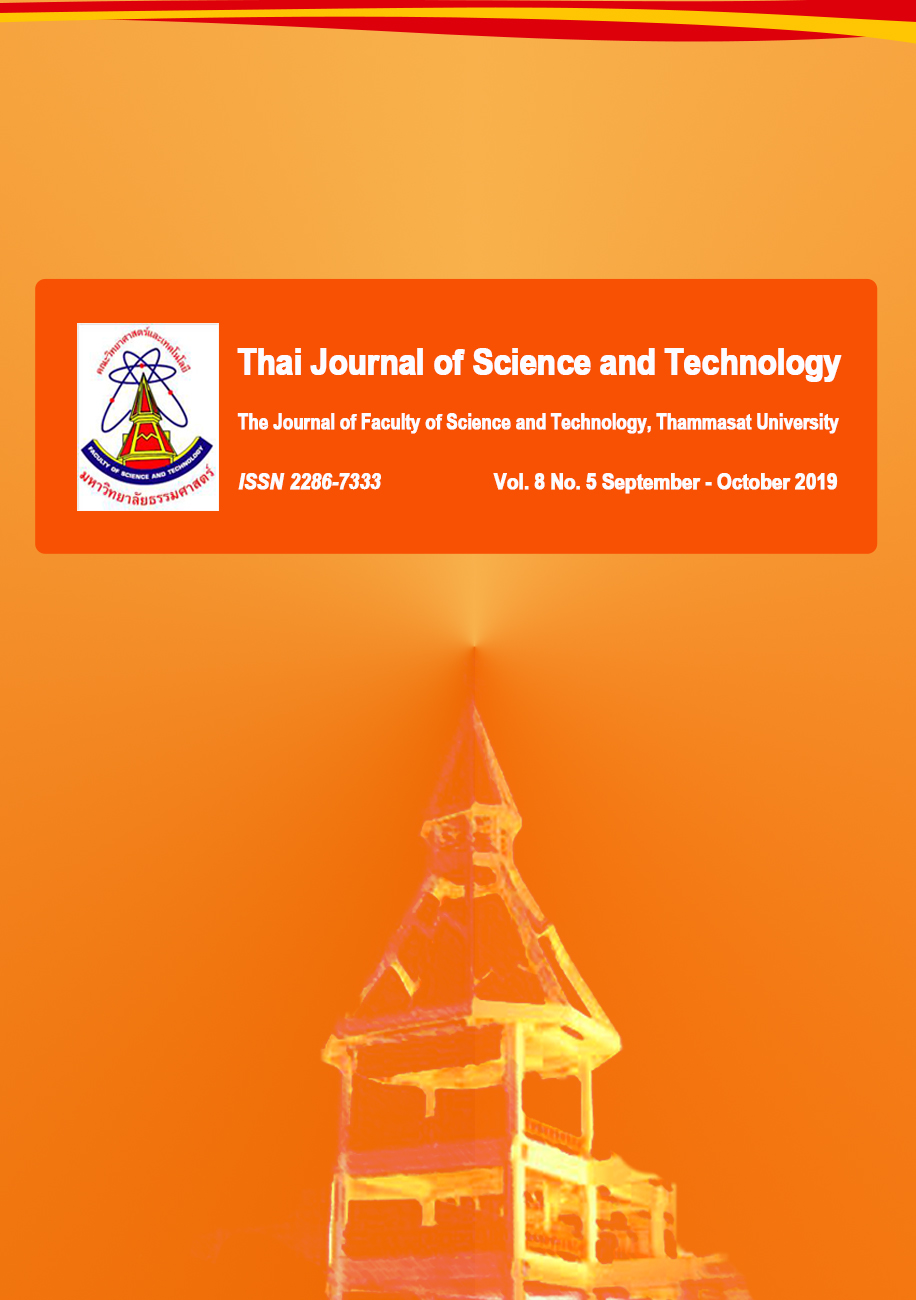การพัฒนากระบวนการเตรียมสารสกัดสมุนไพรไทยที่มีฤทธิ์ต้านอนุมูลอิสระ
Main Article Content
บทคัดย่อ
บทคัดย่อ
กลุ่มโรคไม่ติดต่อเรื้อรังเป็นสาเหตุหลักของการเสียชีวิตก่อนวัยอันควรของประชากรไทย มีผู้ป่วยจำนวนมากที่มีสาเหตุการเกิดโรคมาจากอนุมูลอิสระ ดังนั้นงานวิจัยนี้จึงมุ่งเน้นในการศึกษากระบวนการเตรียมสารสกัดสมุนไพรไทยที่มีฤทธิ์ต้านอนุมูลอิสระจากการสกัดสมุนไพรไทย ได้แก่ แก่นฝาง ผลสมอไทย ผลสมอพิเภก ผลมะขามป้อม และลำต้นบอระเพ็ด ด้วยวิธีการแช่ในเอทานอล เพื่อคัดกรองพืชสมุนไพรที่มีศักยภาพในการต้านอนุมูลอิสระ พบว่าสารสกัดแก่นฝางและสารสกัดผลมะขามป้อมมีฤทธิ์การต้านอนุมูลอิสระและปริมาณสารประกอบฟีนอลิกรวมสูงกว่าสารสกัดสมุนไพรชนิดอื่น เมื่อสกัดด้วยเมทานอล เอทานอล และเอทิลอะซิเตทเพื่อคัดเลือกตัวทำละลายที่เหมาะสม พบว่าเอทานอลยังคงเป็นตัวทำละลายที่เหมาะสม เนื่องจากทำให้ได้สารสกัดที่มีฤทธิ์การต้านอนุมูลอิสระสูง มีปริมาณสารประกอบฟีนอลิกรวมสูง และมีปริมาณฟลาโวนอยด์รวมสูง แม้ว่าการสกัดด้วยเอทานอลจะทำให้มีผลได้การสกัดน้อยกว่าสารสกัดด้วยเมทานอล อย่างไรก็ตาม เอทานอลเป็นตัวทำละลายที่มีความเป็นพิษต่ำและมีราคาถูก จึงมีความเหมาะสมต่อการสกัดสารออกฤทธิ์จากแก่นฝางและผลมะขามป้อมด้วยวิธีการแช่ ทั้งในระดับชุมชุมและระดับอุตสาหกรรม
คำสำคัญ : ฝาง; มะขามป้อม; สมุนไพรไทย; ฤทธิ์การต้านอนุมูลอิสระ; โรคไม่ติดต่อเรื้อรัง
Article Details
บทความที่ได้รับการตีพิมพ์เป็นลิขสิทธิ์ของคณะวิทยาศาสตร์และเทคโนโลยี มหาวิทยาลัยธรรมศาสตร์ ข้อความที่ปรากฏในแต่ละเรื่องของวารสารเล่มนี้เป็นเพียงความเห็นส่วนตัวของผู้เขียน ไม่มีความเกี่ยวข้องกับคณะวิทยาศาสตร์และเทคโนโลยี หรือคณาจารย์ท่านอื่นในมหาวิทยาลัยธรรมศาสตร์ ผู้เขียนต้องยืนยันว่าความรับผิดชอบต่อทุกข้อความที่นำเสนอไว้ในบทความของตน หากมีข้อผิดพลาดหรือความไม่ถูกต้องใด ๆ
เอกสารอ้างอิง
ศรัณยู อุ่นทวี, คุณัญญา เครือจันทร์, สุขวสา เกษียร, ชนัญ ผลประไพ และอรุณพร อิฐรัตน์, 2561, การกักเก็บสารสกัดเปลือกเมล็ดมะขามและสารสกัดผลสมอไทยด้วยไนโอโซมเพื่อการประยุกต์ใช้ในเวชสำอาง, Thai J. Sci. Technol. 7(2): 134-145.
Ames, B.N., Shigenaga, M.K. and Hagen, T.M., 1993, Oxidants, antioxidants, and the degenerative diseases of aging, Proc. Nat. Acad. Sci. USA. 90: 7915-7922.
Camps, J. and García-Heredia, A., 2014. Introduction: Oxidation and Inflammation, a Molecular Link between non-Communicable Diseases, pp. 1-4, In Camps, J. (Ed.), Oxidative Stress and Inflammation in Non-communicable Diseases: Molecular Mecha nisms and Perspectives in Therapeutics, Springer International Publishing, Cham.
Chalise, J.P., Acharya, K., Gurung, N., Bhusal, R.P., Gurung, R., Skalko-Basnet, N. and Basnet, P., 2010, Antioxidant activity and polyphenol content in edible wild fruits from Nepal, Int. J. Food Sci. Nutr. 61: 425-432.
Chellappan, D.R., Purushothaman, A.K. and Brindha, P., 2017, Gastroprotective potential of hydro-alcoholic extract of Pattanga (Caesalpinia sappan Linn.), J. Ethnopharmacol. 197: 294-305.
Chen, Y.X., Tong, J., Ge, L.L., Ma, B.X., He, J.S. and Wang, Y.W., 2015, Ethyl acetate fraction of Terminalia bellirica fruit inhibits rat hepatic stellate cell proliferation and induces apoptosis, Ind. Crops Prod. 76: 364-373.
Hörandl, E. and Hadacek, F., 2013, The oxidative damage initiation hypothesis for meiosis, Plant Reprod. 26: 351-367.
Hwang, H.S. and Shim, J.H., 2018, Brazilin and Caesalpinia sappan L. extract protect epidermal keratinocytes from oxidative stress by inducing the expression of GPX7, Chin. J. Nat. Med. 16: 203-209.
Ilaiyaraja, N. and Khanum, F., 2011, Antioxidant potential of Tinospora cordifolia extracts and their protective effect on oxidation of biomolecules, Phcog. J. 3: 56-62.
Kurtas, O., Yavuz Imre, K., Ozer, E., Can, M., Birincioglu, I., Butun, C., Kirci, G.S., Yildirim, A., Kiyak, S. and Yilmaz, R., 2017, The evaluation of deaths due to methyl alcohol intoxication, Biomed. Res. 28: 3680-3687.
Lee, D.Y., Kim, H.W., Yang, H. and Sung, S.H., 2017, Hydrolyzable tannins from the fruits of Terminalia chebula Retz and their -glucosidase inhibitory activities, Phyto chemistry 137: 109-116.
Li, X., Wu, X. and Huang, L., 2009, Correlation between antioxidant activities and phenolic contents of Radix Angelicae Sinensis (Danggui), Molecules 14: 5349-5361.
Naik Bukke, A., Nazneen Hadi, F., Babu, K.S. and shankar, P.C., 2018, In vitro studies data on anticancer activity of Caesalpinia sappan L. heartwood and leaf extracts on MCF7 and A549 cell lines, Data Brief. 19: 868-877.
Pandey, A.K., Gautam, A., Pandey, P. and Dubey, R.S., 2019, Alleviation of chromium toxicity in rice seedling using Phyllanthus emblica aqueous extract in relation to metal uptake and modulation of antioxidative defense, S. Afr. J. Bot. 121: 306-316.
Pękal, A. and Pyrzynska, K., 2014, Evaluation of aluminium complexation reaction for flavonoid content assay, Food Anal. Methods 7: 1776-1782.
Peterson, C.T., Denniston, K. and Chopra, D., 2017, Therapeutic uses of Triphala in Ayurvedic medicine, J. Altern. Complement Med. 23: 607-614.
R Core Team, 2017, R: A Language and Environment for Statistical Computing.
Ritz, C., Baty, F., Streibig, J.C. and Gerhard, D., 2015, Dose-response analysis using R, PLoS ONE 10(12): e0146021.
Selvam, K., Sudhakar, C., Govarthanan, M., Thiyagarajan, P., Sengottaiyan, A., Senthilkumar, B. and Selvankumar, T., 2017, Eco-friendly biosynthesis and characterization of silver nanoparticles using Tinospora cordifolia (Thunb.) Miers and evaluate its antibacterial, antioxidant potential, J. Radiat. Res. Appl. Sci. 10: 6-12.
Tang, X., Luo, Y.X., Chen, H.Z. and Liu, D.P., 2014, Mitochondria, endothelial cell function, and vascular diseases, Front. Physiol. 5: 1-17.
Tiwari, P., Nayak, P., Prusty, S.K. and Sahu, P.K., 2018, Phytochemistry and pharmaco logy of Tinospora cordifolia: A review, Sys. Rev. Pharm. 9: 70-78.
Tuekaew, J., Siriwatanametanon, N., Wongkra jang, Y., Temsiririrkkul, R. and Jantan, I., 2014, Evaluation of the antioxidant activities of Ya-hom Intajak, a Thai herbal formulation, and its component plants, Trop. J. Pharm. Res. 13: 1477-1485.


